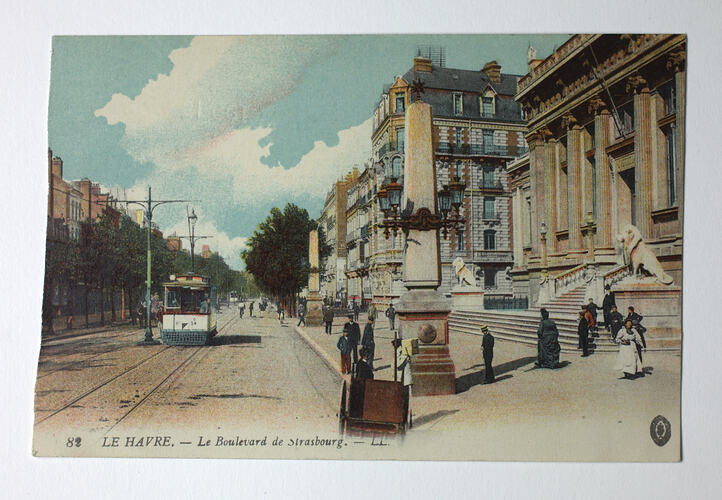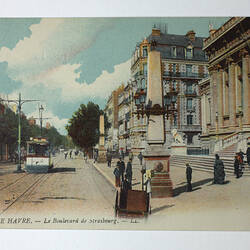Summary
Colour illustration of 'Le Boulevard de Strasbourg' in the port city of Le Havre, France.
Provisionally named 'Franciscopolis' after Francois I of France the city eventually became known as Le-Havre-de-Grace (the Harbour of Grace) after the chapel Notre-Dame-de-Grace that already existed on the site, before it was shortened to 'Le Havre.' Founded in 1517 at the mouth of the Seine, the city provided access to both Rouen and Paris from the English Channel. Following the European discovery of America the city rose to greater prominence and by the end of the 18th century was one of the four premiere ports in France. During World War I the British Expeditionary Force used the city to disembark troops and also as No. 1 Base. The British Expeditionary Force used the city again during World War II for supplies and reinforcements, however the city was bombed in September 1944, resulting in the destruction of 80% of the city.
Today Le Havre is the World Heritage Listed for its pre-World War II architecture and urban development, undertaken by Auguste Perret. The city is also the site of the Commonwealth War Graves Commission Ste. Marie Cemetery. The cemetery consists of 1,690 World War I graves and a further 364 World War II graves. The Salta Memorial was also erected at the site to commemorate those lost in the sinking of the hospital ships Salta (1917) and Galeka (1916) and the transport ship Normandy (1918).
The missive on the back of the postcard is signed by 'Jack,' which is actually a reference to John Peile as ST 40697 is also signed from 'Jack' and lists his service number (2662) with the return address.
Part of a collection of material relating to the World War I service of brothers John and Albert Victor Peile, who both died in the conflict. Younger brother Albert enlisted first. He was a 22-year-old unmarried clerk when he enlisted on 27 August 1914, service number 769, 3rd Battalion. He served in Gallipoli and later France, and was eventually promoted to the rank of corporal. He died in Bullecourt, France on 4 May 1917 and his body was never found. He is commemorated at the Villers-Bretonneux Memorial. His brother John Peile was a 38-year-old unmarried miner when he enlisted on 25 June 1915, service number 2662, 2nd Battalion. He also served in in Gallipoli and France, and was similarly promoted to corporal. He died in France on 18 September 1918 and is buried at Roisel Communal Cemetery Extension, France. Their mother died only a few years later in 1926, aged 73.
Their niece was Mrs M. J. Hitchens, the donor. Margaret Joan Hitchens (1916-?) was the daughter of Albert and John's sister Alice and her husband John Henry Dinwoodie.
Description of Content
Tram on boulevard, passing low-rise buildings.
Physical Description
Colour illustration printed onto paper.
More Information
-
Collection Names
-
Collecting Areas
-
Acquisition Information
Donation from Victorian Branch, Returned & Services League of Australia Limited (RSL), Mrs Margaret J. Hitchens, 1986
-
Author
Corporal John '. Peile - Australian Imperial Force (AIF), 20 Oct 1917
-
Place Depicted
-
Inscriptions
Printed on front: '92 LE HAVRE. - Le Boulevard de Strasbourg. - LL.' Printed on back: 'CARTE POSTALE / Correspondance LL Adresse / Modele Depose' Printed vertically on back centre: 'LEVY FILS & CIE, PARIS.' Handwritten on back: '20/10/17 / With Best love to all / from your fond son / Jack / I am quite / well hoping you / are all the same'
-
Classification
-
Category
-
Discipline
-
Type of item
-
References
'History of the City,' Le Havre, at: [Link 1] accessed: June 18, 2012 'Le Havre, the City Rebuilt by Auguste Perret,' UNESCO World Heritage List, at: [Link 2] accessed: June 18, 2012 'Le Havre,' Wikipedia, at: [Link 3] accessed: June 18, 2012 For Albert Peile's war record see the National Archives of Australia website at: [Link 4] For John Peile's war record see the National Archive of Australia website at: [Link 5]
-
Keywords


